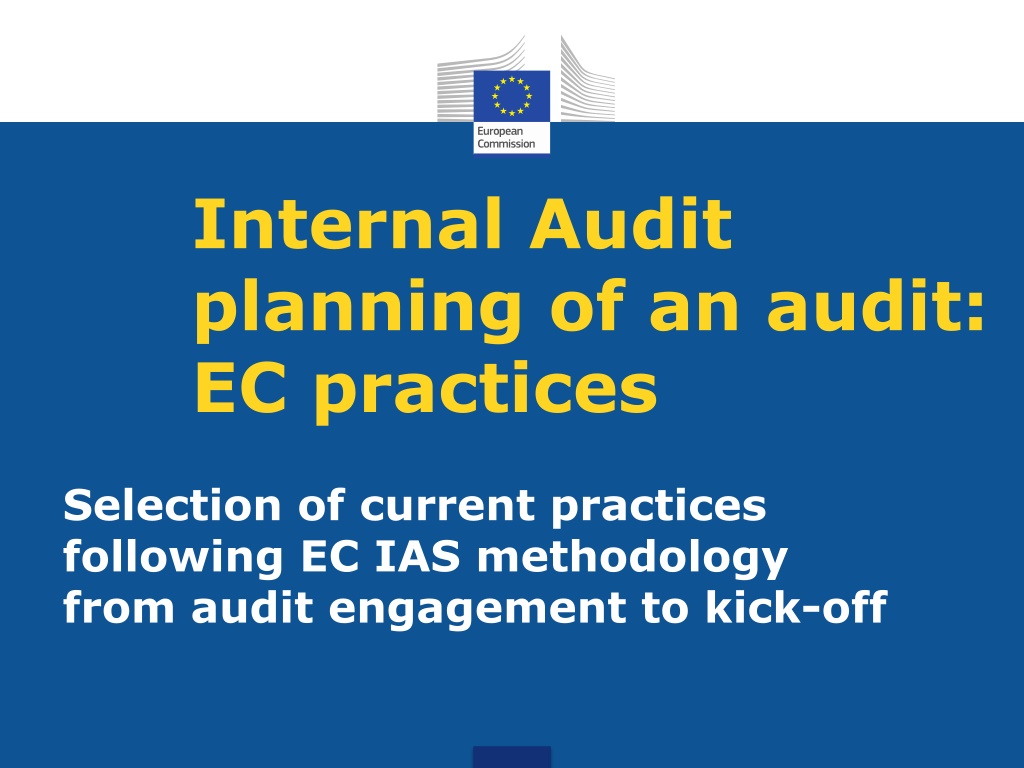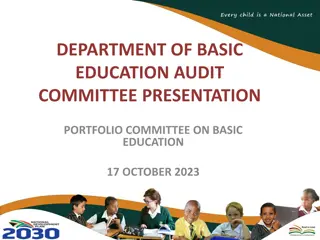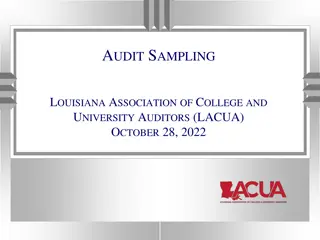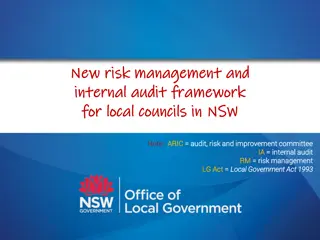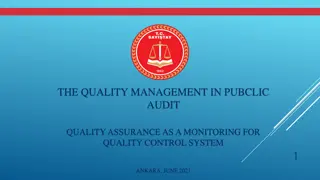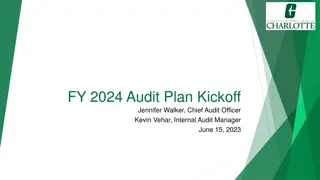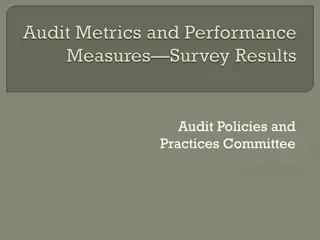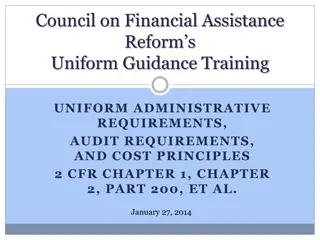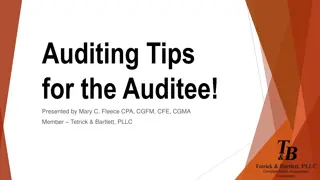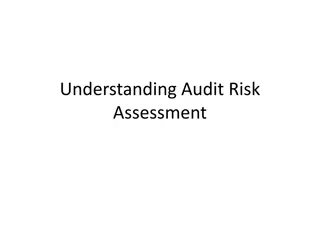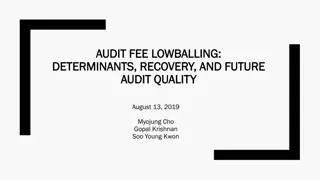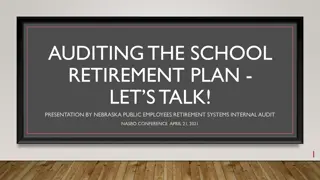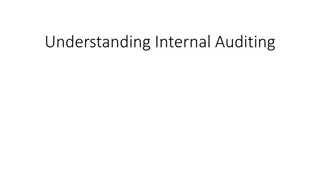Internal Audit Planning and Practices for Effective Risk Management
Planning an internal audit following EC practices is crucial for enhancing and protecting organizational value. The Internal Audit Service's mission focuses on providing risk-based assurance and advice to improve risk management, control, and governance processes. From audit engagement to kick-off, practices such as annual planning, audit scheduling, and audit creation in software like TeamMate ensure a systematic and disciplined approach to evaluating and improving effectiveness. This process involves aligning audit resources, setting milestones, and monitoring consumption to achieve audit objectives successfully.
Download Presentation

Please find below an Image/Link to download the presentation.
The content on the website is provided AS IS for your information and personal use only. It may not be sold, licensed, or shared on other websites without obtaining consent from the author. Download presentation by click this link. If you encounter any issues during the download, it is possible that the publisher has removed the file from their server.
E N D
Presentation Transcript
Internal Audit planning of an audit: EC practices Selection of current practices following EC IAS methodology from audit engagement to kick-off
IAS mission From IAS audit Charter: "The mission of the Internal Audit Service is to enhance and protect organisational value by providing risk-based and objective assurance, advice and insight. The IAS helps the Commission accomplish its objectives by bringing a systematic, disciplined approach in order to evaluate and improve the effectiveness of risk management, control and governance processes."
The Commissions governance and internal audit environment Audit Progress Committee (APC) College of Commissioners First Vice-President Timmermans Internal Audit DG Internal Audit Service DG Directorate-General A.B. Board A.B. Board Board Internal Audit Internal Audit A.B. Executive Agencies Executive Agencies Executive Agencies Community Agencies Community Agencies Autonomous Body/ Community Agency 3
Practice 1: from Audit Plan to Audit Engagement The Annual Plan is part of a multi-annual strategic plan, based on an in-depth risk assessment updated annually Annual audit plan contains indicative audit title, general objective, audit budget, year of completion, Unit responsible see example 1 The Unit refer to its capacity planning and matches the availability of auditors with the needed skills and auditors interest Teams of 2-3 auditors, audit budget generally in the range of 90-200 days depending on the scope
Practice 2: audit scheduling Indicative milestones agreed with HoU in the audit creation form (see example 2) Take into account: Average time dedicated to audits Team or 2/3, experienced/newcomers In general 25-40% for preliminary survey, 40- 65% for fieldwork, 20% for reporting IT or other specific expertise needed Overlapping with other annually recurring activities (RA, SAP, OO, APC reporting)
Practice 3: audit creation in audit software Audit created in audit software (TeamMate) defining roles, time budget, milestones This activates the possibility to charge audit hours to this engagement in timesheets (see example 3a) Consequent monitoring of consumption of audit budget (see example 3b) and of milestones by management (radar screen) The audit software is key to document and to supervise the audit work
Practice 4: Announcement Letter Official announcement letter sent at least 1 month in advance of the opening meeting (see example 4) Request for contact person in the audited entity, who will act as an entry point and facilitator Sent together with Mutual Expectation paper (see next practice) + annex on personal data, where the IAS asks the DG Management to send to all staff concerned a notification of the possible use of "personal data" during the audit
Practice 5: Mutual Expectations paper What you should expect from the IAS, What the IAS expects from you See example 5 it contains a.o.: timing to be expected for main audit communication/steps Rights and obligations of auditors and auditees
Practice 6: Opening Meeting The opening meeting is organised with the contact person and/or other representatives of the Director General to: Provide more details about the audit objectives, the scope, and the audit methodology to be followed; Have an exchange of views on the audit and its timing and the issues of interest and expectations of the Directorate or Unit; Identify the main contact points and how and with whom the audit findings will be validated during the fieldwork; Present two important documents : Mutual Expectation Paper / Obligations related to Data protection; Discuss logistics and timelines.
Preliminary Survey Aims to obtain a better understanding of the audited process and of the related risks to better define the objectives and scope of the engagement, by: Review of relevant documentation Interviews Data analysis Documented in the audit software tool Output: Engagement Planning Memorandum
Practice 7: Engagement Planning Memorandum (EPM) The main output of the preliminary survey is the EPM (see example 6) The EPM represents the actual planning of the audit It contains: The objective of the audit The audit scope The timeline The human resources for the engagement The audit programme together with process description, background information, main figures, summary of previous related audits, audit methodology, etc. Reviewed by management and QA and approved by management
Practice 8: Detailed audit programme Either: RCM (Risk and Control Matrix) Used for financial/compliance audits See example 7 or PAM (Performance Audit Matrix) Used for performance/comprehensive audits See example 8
Practice 9: Communication to auditees: Scoping Memo The Scoping Memo is an extract of the EPM sent to the auditees as input for the kick-off meeting See example 9
Kick-off Meeting Meeting to be held by the IAS with the Director(s)-General or Head(s) of Service(s) concerned. The IAS will be represented by the Audit Head of Unit and, when appropriate, the Audit Process Director and/or Director-General Purpose: Establish an open and constructive dialogue with the management team of the DG(s) or Service(s) Present Scoping Memo Provide more details about The audit objectives and planned scope, The audit methodology to be followed The parties that will be audited The special security measures, if any Ask the auditee what their expectations are (and refine EPM if necessary)
